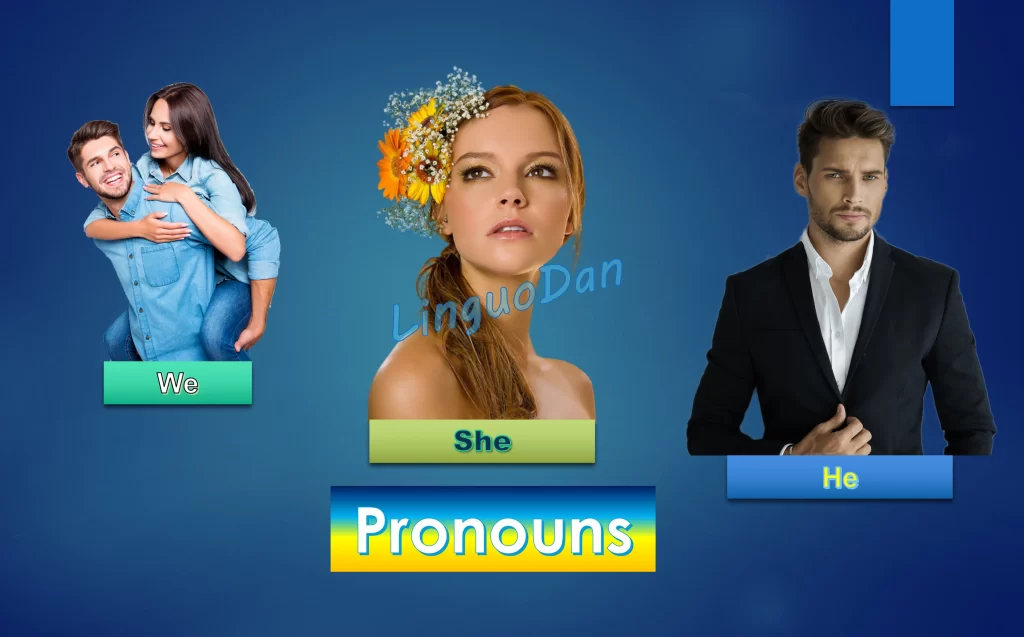Pronouns in English in practice

What are pronouns and how to use them in English?
Pronouns in English are parts of speech that are used to replace nouns, adjectives, or numerals, helping to avoid repetition in a sentence. Pronouns can refer to a person, thing, place, or idea. In this way, pronouns help to make the language more diverse and easy to understand. Let’s consider some basic types of pronouns and their use.
Personal Pronouns
- I – Used when referring to oneself.
- You – Used when addressing someone directly, whether singular or plural.
- He – Used when referring to a male person or animal.
- She – Used when referring to a female person or animal.
- It – Used when referring to an inanimate object, animal, or something without a specific gender.
- We – Used when referring to a group that includes oneself.
- They – Used when referring to a group of people or things.
They are used to replace a noun when talking about yourself or another person.
Examples:
- She is my friend.
- We are going to the store.
Demonstrative Pronouns
- This (this, can be used for both animate and inanimate objects nearby)
- That (that, for animate and inanimate objects at a distance)
- These (these, for many nearby objects)
- Those (those, for many distant objects)
Demonstrative pronouns indicate specific objects or persons.
Examples:
- This is my book.
- I like those shoes.
Interrogative Pronouns
- Who – Used to ask about a person or people.
- Whom – Used to ask about the object of an action or to inquire about a person in a formal context.
- What – Used to ask about things or actions.
- Which – Used to inquire about a specific choice among options.
Interrogative pronouns are used to form questions and seek information.
Examples:
- Who is at the door?
- What is your name?
- Who is that?
Possessive Pronouns
- My – Indicates ownership by the speaker.
- Your – Indicates ownership by the person or persons being addressed.
- His – Indicates ownership by a male person or thing.
- Her – Indicates ownership by a female person or thing.
- Its – Indicates ownership by an inanimate object or animal.
- Our – Indicates ownership by the speaker and others.
- Their – Indicates ownership by a group of people or things.
Possessive pronouns are used to show ownership or possession.
Examples:
- This is my house.
- Those are their children.
- This is my car.
Indefinite Pronouns
- Some – Refers to an unspecified or undetermined quantity or number of people or things.
- Any – Used to refer to one or more items or individuals from a set without specifying which.
- Everyone – Refers to all the people in a group.
- Someone – Refers to an unspecified person.
- Nobody – Refers to no person or not a single individual.
Indefinite pronouns are used to indicate an unspecified quantity or person.
Examples:
- Somebody called for you.
- Have you seen anyone around?
Reciprocal Pronouns
- Each other – Used when two people or things perform an action mutually.
- One another – Similar to “each other,” used for reciprocal actions involving more than two people or things.
They indicate interaction between persons or objects.
Examples:
- They love each other.
- The team members support one another.
Relative Pronouns
- Who – Used to introduce a relative clause that describes or identifies a person or people.
- Whom – Used in a relative clause when referring to the object of a verb or a preposition.
- Which – Used to introduce a relative clause that describes or identifies a thing or things.
- That – Used to introduce a relative clause that describes or identifies both people and things.
Relative pronouns are used to introduce relative clauses that provide additional information about a noun in the sentence.
Examples:
- The person who called is waiting.
- The book that I am reading is interesting.
Practice for testing knowledge on the use of pronouns with 20 questions